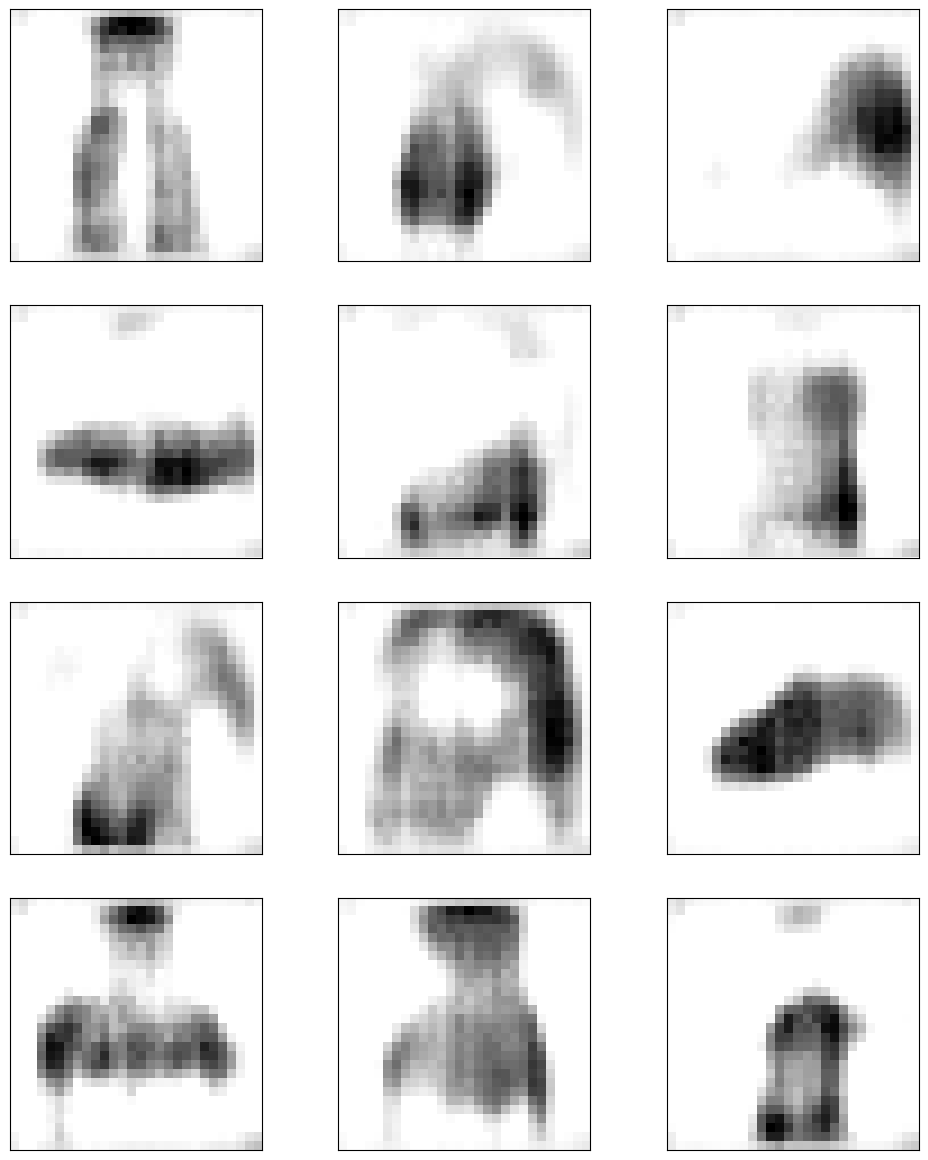Vanilla Variational Autoencoder (vVAE)
import torch
import pandas as pd
import numpy as np
import matplotlib.pyplot as plt
import warnings
import umap
import os
from sklearn.model_selection import train_test_split
from sklearn.manifold import TSNE
from torch.utils.data import DataLoader
from torchvision import datasets, transforms
from tqdm import tqdm
# GOJO libraries
from gojo import deepl
from gojo import plotting
from gojo import core
from gojo import interfaces
DEVICE = 'cuda'
C:Usersfgarciaanaconda3envsmlv0libsite-packagestqdmauto.py:21: TqdmWarning: IProgress not found. Please update jupyter and ipywidgets. See https://ipywidgets.readthedocs.io/en/stable/user_install.html from .autonotebook import tqdm as notebook_tqdm
Data loading
# FashionMNIST labels (https://github.com/zalandoresearch/fashion-mnist)
labels = {
0: 'T-shirt/top',
1: 'Trouser',
2: 'Pullover',
3: 'Dress',
4: 'Coat',
5: 'Sandal',
6: 'Shirt',
7: 'Sneaker',
8: 'Bag',
9: 'Ankle boot'
}
# define the transformation used to load the images
transform = transforms.Compose([
transforms.ToTensor(),
])
# download the FashionMNIST datasets (train/test)
train_dataset = datasets.FashionMNIST(
root=os.path.join(os.path.expanduser('~'), 'test_datasets', 'pytorch'),
train=True, transform=transform, download=True)
test_dataset = datasets.FashionMNIST(
root=os.path.join(os.path.expanduser('~'), 'test_datasets', 'pytorch'),
train=False, transform=transform, download=True)
# plot some examples
np.random.seed(1997)
fig, axes = plt.subplots(2, 3, figsize=(10, 5))
for i, ax in enumerate(axes.flatten()):
img, label = train_dataset[np.random.choice(len(train_dataset))]
img_np = img.numpy().squeeze(0)
ax.imshow(img_np, cmap='Greys')
ax.set_xticks([])
ax.set_yticks([])
ax.set_title(labels[label])
plt.show()
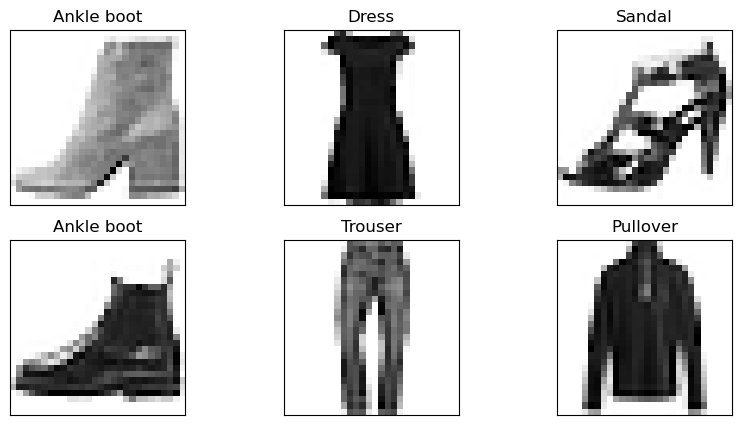
# separate the training data into train (85%) and validation (15%)
train_dataset, valid_dataset = torch.utils.data.random_split(
train_dataset,
[
int(len(train_dataset) * 0.85),
int(len(train_dataset) * 0.15)
],
torch.Generator().manual_seed(1997)
)
print('Train: %d' % len(train_dataset))
print('Valid: %d' % len(valid_dataset))
print('Test: %d' % len(test_dataset))
# create the dataloaders
train_dl = DataLoader(
train_dataset,
batch_size=1028, shuffle=True)
valid_dl = DataLoader(
valid_dataset,
batch_size=4096, shuffle=False)
test_dl = DataLoader(
test_dataset,
batch_size=4096, shuffle=False)
Train: 51000
Valid: 9000
Test: 10000
Model training
# create a simple variational autoencoder
model = deepl.models.VanillaVAE(
encoder=torch.nn.Sequential(
torch.nn.Conv2d(1, 16, (3, 3)),
torch.nn.ReLU(),
torch.nn.BatchNorm2d(16),
torch.nn.Conv2d(16, 32, (3, 3)),
torch.nn.ReLU(),
torch.nn.BatchNorm2d(32),
torch.nn.MaxPool2d(2),
torch.nn.Conv2d(32, 16, (3, 3)),
torch.nn.ReLU(),
torch.nn.BatchNorm2d(16),
torch.nn.MaxPool2d(2),
torch.nn.Conv2d(16, 8, (2, 2)),
torch.nn.ReLU(),
torch.nn.BatchNorm2d(8),
torch.nn.Flatten()
),
encoder_out_dim=128,
decoder=torch.nn.Sequential(
torch.nn.Linear(128, 288),
torch.nn.ReLU(),
torch.nn.Unflatten(1, (8, 6, 6)),
torch.nn.ConvTranspose2d(8, 16, kernel_size=(4, 4)),
torch.nn.ReLU(),
torch.nn.ConvTranspose2d(16, 32, kernel_size=(4, 4)),
torch.nn.ReLU(),
torch.nn.ConvTranspose2d(32, 16, kernel_size=(3, 3), stride=2),
torch.nn.ReLU(),
torch.nn.ConvTranspose2d(16, 8, kernel_size=(2, 2), stride=1),
torch.nn.ReLU(),
torch.nn.ConvTranspose2d(8, 1, kernel_size=(3, 3), stride=1),
torch.nn.ReLU(),
),
decoder_in_dim=128,
latent_dim=10
)
# with torch.no_grad():
# tX = torch.Tensor(X[:12])
# out = model(tX)
# out[0].shape, out[1]['mu'].shape, out[1]['logvar'].shape
output = deepl.fitNeuralNetwork(
deepl.iterUnsupervisedEpoch,
model=model,
train_dl=train_dl,
valid_dl=valid_dl,
n_epochs=40,
loss_fn=deepl.loss.ELBO(kld_weight=0.00005),
optimizer_class=torch.optim.Adam,
optimizer_params={'lr': 0.0001},
device=DEVICE,
)
Training model...: 100%|███████████████████████████████████████████████████████████████| 40/40 [02:30<00:00, 3.77s/it]
Model convergence
train_info = output['train']
valid_info = output['valid']
plotting.linePlot(
train_info, valid_info,
x='epoch', y='loss (mean)', err='loss (std)',
labels=['Train', 'Validation'],
title='Model convergence',
ls=['solid', 'dashed'],
style='default', legend_pos='center right'
)
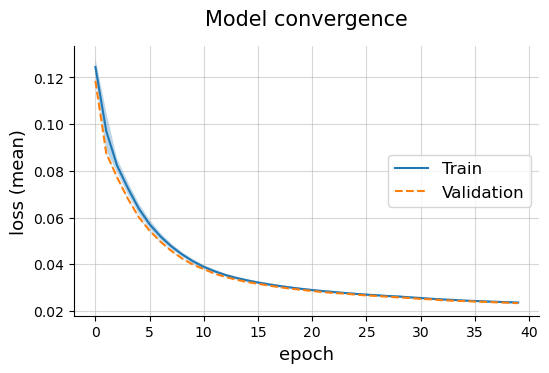
plotting.linePlot(
train_info, valid_info,
x='epoch', y='reconstruction_loss',
labels=['Train', 'Validation'],
title='Model convergence (reconstruction loss)',
ls=['solid', 'dashed'],
style='default', legend_pos='center right'
)
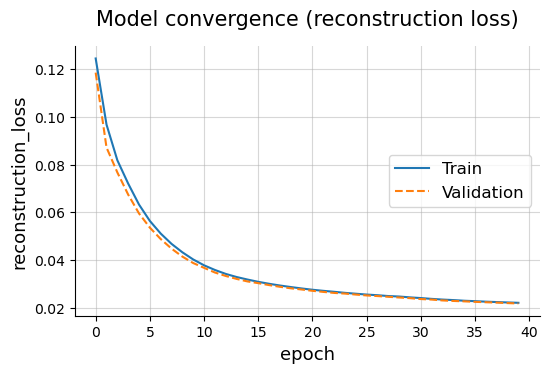
plotting.linePlot(
train_info, valid_info,
x='epoch', y='KLD',
labels=['Train', 'Validation'],
title='Model convergence (KL-divergence)',
ls=['solid', 'dashed'],
style='default', legend_pos='center right'
)
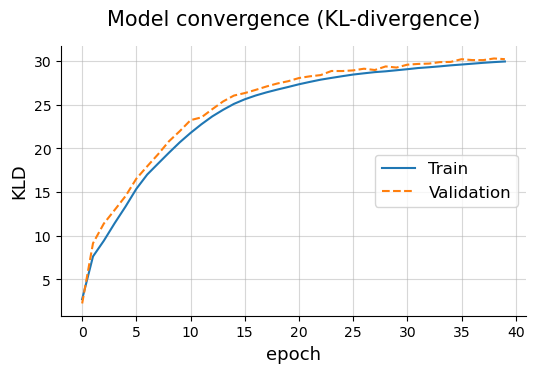
Model evaluation
Analyze the reconstruction error
# load some examples
np.random.seed(1000)
model = model.eval()
n_examples = 5
tX_test_ex = []
label_test_ex = []
test_indices = []
tX_train_ex = []
label_train_ex = []
train_indices = []
for i in range(n_examples):
# get test image
idx = np.random.choice(len(test_dataset))
test_indices.append(idx)
img, label = test_dataset[idx]
tX_test_ex.append(img)
label_test_ex.append(labels[label])
# get train image
idx = np.random.choice(len(train_dataset))
train_indices.append(idx)
img, label = train_dataset[idx]
tX_train_ex.append(img)
label_train_ex.append(labels[label])
tX_test_ex = torch.cat(tX_test_ex)
tX_train_ex = torch.cat(tX_train_ex)
# reconstruct input
with torch.no_grad():
r_tX_test_ex = model(tX_test_ex.unsqueeze(1).to(device=DEVICE))[0]
r_tX_train_ex = model(tX_train_ex.unsqueeze(1).to(device=DEVICE))[0]
r_X_test_ex = r_tX_test_ex.squeeze(1).cpu().numpy()
r_X_train_ex = r_tX_train_ex.squeeze(1).cpu().numpy()
# display exapmles for the training data
fig, axes = plt.subplots(n_examples, 2, figsize=(8, 3*n_examples))
fig.tight_layout()
for i in range(len(axes)):
for ii in range(len(axes[i])):
ax = axes[i, ii]
if ii == 0:
ax.imshow(r_X_train_ex[i], cmap='Greys')
ax.set_title('Reconstructed (train)')
else:
ax.imshow(train_dataset[train_indices[i]][0].numpy().squeeze(), cmap='Greys')
ax.set_title('Original (train)')
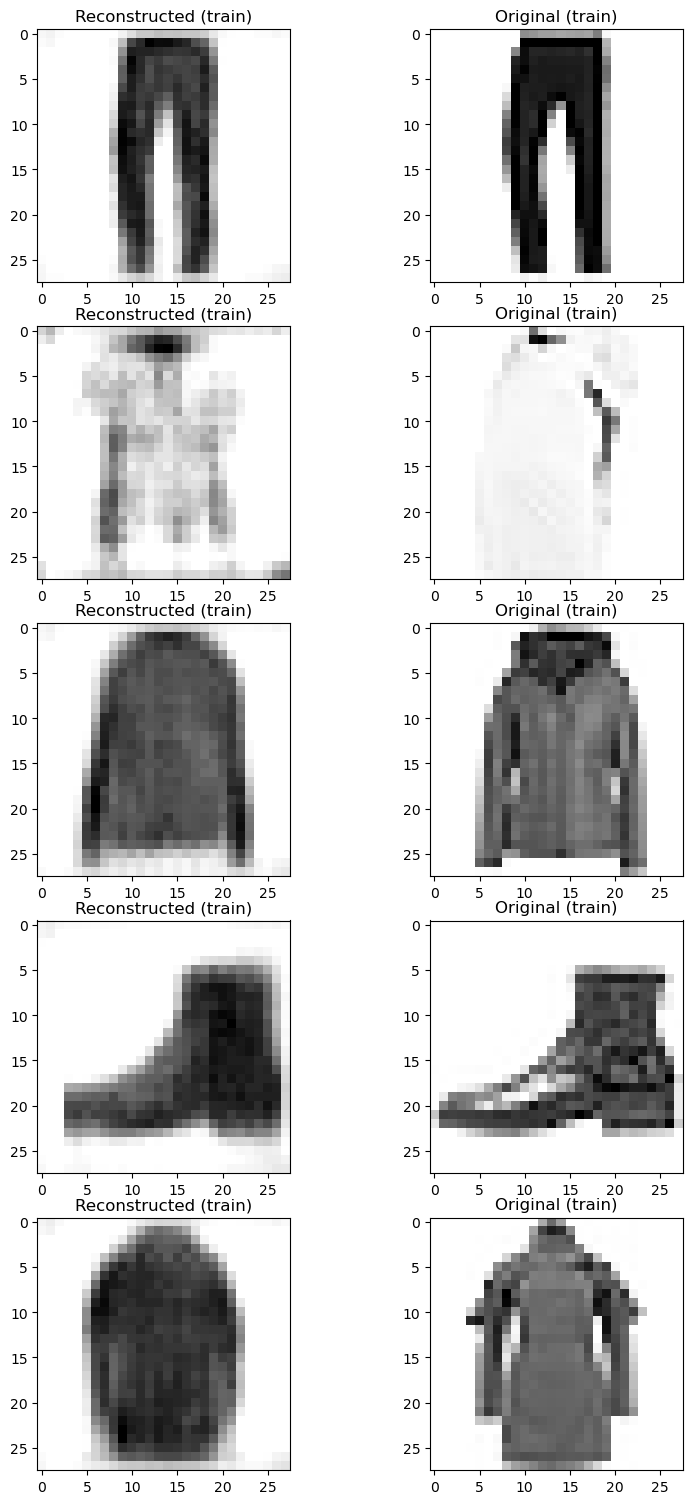
# display exapmles for the test data
fig, axes = plt.subplots(n_examples, 2, figsize=(8, 3*n_examples))
fig.tight_layout()
for i in range(len(axes)):
for ii in range(len(axes[i])):
ax = axes[i, ii]
if ii == 0:
ax.imshow(r_X_test_ex[i], cmap='Greys')
ax.set_title('Reconstructed (test)')
else:
ax.imshow(test_dataset[test_indices[i]][0].numpy().squeeze(), cmap='Greys')
ax.set_title('Original (test)')
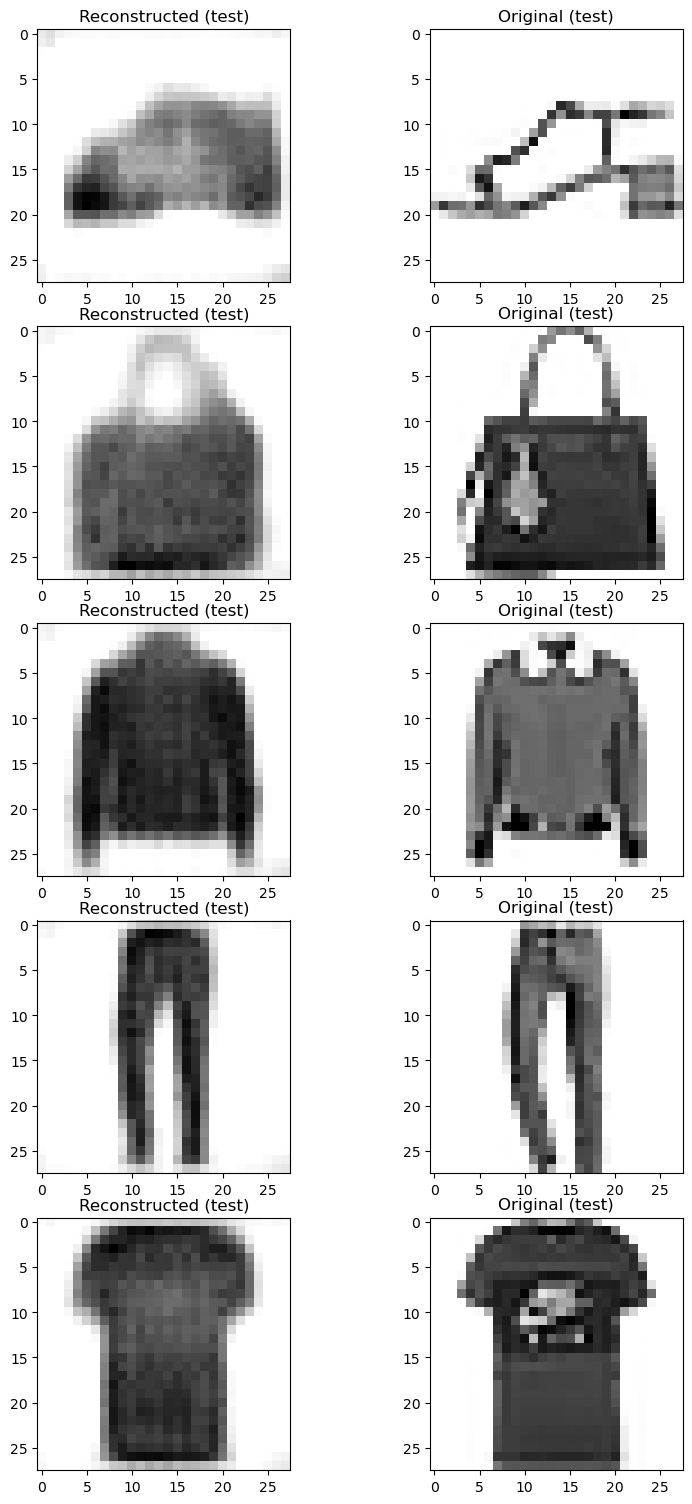
Compute regression metrics
metric_stats = []
for tX, tY in tqdm(test_dl):
with torch.no_grad():
rtX = model(tX.to(device=DEVICE))[0]
with warnings.catch_warnings(record=True) as w:
warnings.simplefilter("always")
metric_stats.append(core.getScores(
tX.cpu().numpy().reshape(tX.shape[0], -1),
rtX.cpu().numpy().reshape(tX.shape[0], -1),
core.getDefaultMetrics('regression')
))
metric_stats_df = pd.DataFrame(metric_stats)
pd.DataFrame(metric_stats_df.mean(), columns=['Score']).round(decimals=3)
100%|████████████████████████████████████████████████████████████████████████████████████| 3/3 [00:02<00:00, 1.30it/s]
| Score | |
|---|---|
| explained_variance | -10.559 |
| mse | 0.022 |
| mae | 0.081 |
| r2 | -122.206 |
| pearson_correlation | 0.327 |
Visualize embedding dimensions
# generate model embeddings (using the mean vector)
embeddings = []
label_idx = []
n_samples = 12
samples = model.sample(n_samples, current_device=DEVICE)
samples = samples.cpu().numpy().squeeze()
for tX, label in tqdm(test_dl):
with torch.no_grad():
vae_emb = model.encode(tX.to(device=DEVICE))[0].cpu().numpy()
embeddings.append(vae_emb)
label_idx.append(label.numpy())
embeddings = np.concatenate(embeddings)
n_samples = 12
samples = model.sample(n_samples, current_device=DEVICE)
samples = samples.cpu().numpy().squeeze()
label_idx = np.concatenate(label_idx)
100%|████████████████████████████████████████████████████████████████████████████████████| 3/3 [00:00<00:00, 6.49it/s]
# generate 2d embeddings
emb2d = umap.UMAP(n_components=2).fit_transform(embeddings)
fig, ax = plt.subplots()
for i, label in labels.items():
label_mask = label_idx == i
ax.scatter(
emb2d[label_mask, 0],
emb2d[label_mask, 1],
label=label, s=20
)
ax.spines['top'].set_visible(False)
ax.spines['right'].set_visible(False)
ax.set_title('Embedding projection')
ax.set_xlabel('Emb 0')
ax.set_ylabel('Emb 1')
ax.grid(alpha=0.2, color='grey')
ax.legend(loc=(1.04, 0))
plt.show()
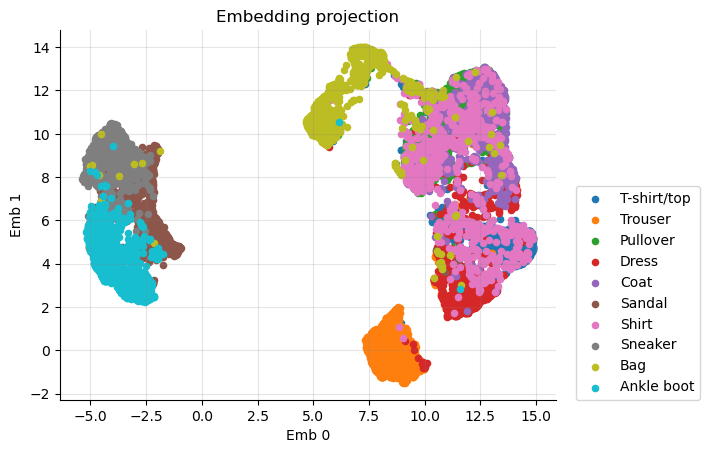
Generate samples
n_samples = 12
samples = model.sample(n_samples, current_device=DEVICE)
samples = samples.cpu().numpy().squeeze()
fig, axes = plt.subplots(n_samples // 3, 3, figsize=(10, 3 * (n_samples // 3)))
fig.tight_layout()
for i, ax in enumerate(axes.flatten()):
ax.imshow(samples[i], cmap='Greys')
ax.set_xticks([])
ax.set_yticks([])
